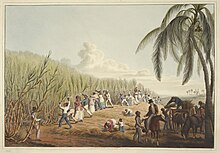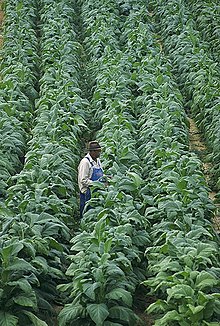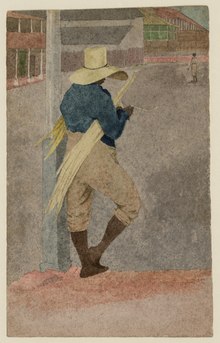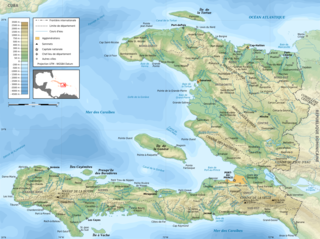This article needs additional citations for verification .(August 2023) |
A slave plantation was an agricultural farm that used enslaved people for labour. The practice was abolished in most places during the 19th century.
This article needs additional citations for verification .(August 2023) |
A slave plantation was an agricultural farm that used enslaved people for labour. The practice was abolished in most places during the 19th century.

Planters embraced the use of slaves mainly because indentured labor became expensive. Some indentured servants were also leaving to start their farms as land was widely available. Colonists in the Americas tried using Native Americans for labor, but they were susceptible to European diseases and died in large numbers. The plantation owners then turned to enslaved Africans for labor. In 1665, there were fewer than 500 Africans in Virginia but by 1750, 85 percent of the 235,000 slaves in the Thirteen Colonies lived in the southern colonies, Virginia included. Africans made up 40 percent of the South's population. [1] [ page needed ]
According to the 1840 United States Census, one out of every four families in Virginia owned slaves. There were over 100 plantation-owners who owned over 100 slaves. [2] The number of slaves in the 15 States was just shy of 4 million in a total population of 12.4 million and the percentage was 32% of the population.
Fewer than one-third of Southern U.S. families owned slaves at the peak of slavery prior to the outbreak of the American Civil War in 1861. In Mississippi and South Carolina, the figure approached one-half. The total number of slave owners was 385,000 (including, in Louisiana, some free African Americans), amounting to approximately 3.8% of the Southern and Border states population.

On a plantation with more than 100 slaves, the capital value of the slaves was greater than the capital value of the land and farming implements.
Slave-powered latifundia featured in the economy of territories of classical Rome from the 2nd century BCE. The first slave plantations in the New World originated in the Caribbean islands, particularly in the West Indies on the island of Hispaniola, where Spaniards introduced the system in the early 16th century CE. The plantation system, based on slave labor, was marked by inhumane methods of exploitation. After being established in the Caribbean islands, the plantation system spread during the 16th, 17th, and 18th centuries to European colonies in the Americas and Asia. All the plantation systems had a form of slavery in their establishment: slaves were initially forced to be laborers in the plantation system; these slaves were primarily native Indians, but the system was later extended to include slaves shipped from Africa. Indeed, the progress of the plantation system was accompanied by the rapid growth of the slave trade.
The plantation system peaked in the first half of the 18th century,[ citation needed ] but later on, during the middle of 19th century, there was a significant increase in demand for cotton from European countries, which led to the expansion of the plantation system in the southern parts of United States. This made the plantation system reach a profound crisis,[ citation needed ] until it changed from depending on forced slave labour to employing mainly low-paid wage laborers with a smaller proportion of forced labour. In the late-19th century, monopolies ensured high profits from the sale of plantation products by exploiting cheap labourers, forced recruitment, peonage and debt servitude in Asia, Africa, and Latin America. [3]
The new-fangled factories of the industrial revolution adopted some of the management practices of the slave plantations in order to organise and control their growing workforces. [4]
Enslaved Africans were brought from Africa by European slave traders to the Americas. They were shipped from ports in West Africa to European colonies in the Americas. The journey from Africa across the Atlantic Ocean was called "the middle passage", and was one of the three legs which comprised the triangular trade among the continents of Europe, the Americas, and Africa.
By some estimates, it is said that some ten million Africans were brought to the Americas. Only about 6% ended up in the North American colonies, while the majority were taken to the Caribbean colonies and South America. A reason many did not make it to the colonies at all was disease and illness. Underneath the slave ship's decks, Africans were held chest-to-chest and could not do much moving. There was waste and urine throughout the hold; this caused the captives to get sick and die from illnesses that could not be cured. [5]
As the plantation economy expanded, the slave trade grew to meet the growing demand for labor. [6]
Western Europe was the final destination for the plantation produce. At this time, Europe was starting to industrialize, and it needed a lot of materials to manufacture goods. Being the power center of the world at the time, they exploited the New World and Africa to industrialize. Africa supplied slaves for the plantations; the New World produced raw materials for industries in Europe. Manufactured goods, of higher value, were then sold both to Africa and the New World. The system was largely run by European merchants [7]

Sugar has a long history as a plantation crop. Cultivation of sugar had to follow a precise scientific system to profit from the production. Sugar plantations everywhere were disproportionate consumers of labor, often enslaved, because of the high mortality of the plantation laborers. In Brazil, plantations were called casas grandes and suffered from similar issues.
The slaves working the sugar plantation were caught in an unceasing rhythm of arduous labor year after year. Sugarcane is harvested about 18 months after planting and the plantations usually divided their land for efficiency. One plot was lying fallow, one plot was growing cane, and the final plot was being harvested. During the December–May rainy season, slaves planted, fertilized with animal dung, and weeded. From January to June, they harvested the cane by chopping the plants off close to the ground, stripping the leaves and then cutting them into shorter strips to be bundled off to be sent to the sugar cane mill.
In the mill, the cane was crushed using a three-roller mill. The juice from the crushing of the cane was then boiled or clarified until it crystallized into sugar. Some plantations also went a step further and distilled the molasses, the liquid left after the sugar is boiled or clarified, to make rum. The sugar was then shipped back to Europe. For the slave laborer, the routine started all over again.
With the 19th-century abolition of slavery, plantations continued to grow sugar cane, but sugar beets, which can be grown in temperate climates, increased their share of the sugar market.
| | This section needs expansionwith: Adding information about Indigo cultivation during 1850s and Nil Bidroha. You can help by adding to it. (August 2023) |
Indigofera was a major crop cultivated during the 18th century, in Venezuela, Guatemala—and Haiti until the slave rebellion against France that left them embargoed by Europe and India in the 19th and 20th centuries. The indigo crop was grown for making blue indigo dye in the pre-industrial age.
Mahatma Gandhi's investigation of indigo workers' claims of exploitation led to the passage of the Champaran Agrarian Bill in 1917 by the Government of India.

Plantations are farms specializing in cash crops, usually mainly planting a single crop, with perhaps ancillary areas for vegetables for eating and so on. Plantations, centered on a plantation house, grow crops including cotton, cannabis, coffee, tea, cocoa, sugar cane, opium, sisal, oil seeds, oil palms, fruits, rubber trees and forest trees. Protectionist policies and natural comparative advantage have sometimes contributed to determining where plantations are located.

Slavery in the colonial history of the United States refers to the institution of slavery as it existed in the European colonies which eventually became part of the United States. In these colonies, slavery developed due to a combination of factors, primarily the labour demands for establishing and maintaining European colonies, which had resulted in the Atlantic slave trade. Slavery existed in every European colony in the Americas during the early modern period, and both Africans and indigenous peoples were victims of enslavement by European colonizers during the era.

Indentured servitude is a form of labor in which a person is contracted to work without salary for a specific number of years. The contract, called an "indenture", may be entered voluntarily for purported eventual compensation or debt repayment, or imposed involuntarily as a judicial punishment. Many came with forged or no contract they ever saw.

Sugar plantations in the Caribbean were a major part of the economy of the islands in the 18th, 19th, and 20th centuries. Most Caribbean islands were covered with sugar cane fields and mills for refining the crop. The main source of labor, until the abolition of chattel slavery, was enslaved Africans. After the abolition of slavery, indentured laborers from India, China, Portugal and other places were brought to the Caribbean to work in the sugar industry. These plantations produced 80 to 90 percent of the sugar consumed in Western Europe, later supplanted by European-grown sugar beet.
A plantation economy is an economy based on agricultural mass production, usually of a few commodity crops, grown on large farms worked by laborers or slaves. The properties are called plantations. Plantation economies rely on the export of cash crops as a source of income. Prominent crops included Red Sandalwood, cotton, rubber, sugar cane, tobacco, figs, rice, kapok, sisal, and species in the genus Indigofera, used to produce indigo dye.

Slavery in the British and French Caribbean refers to slavery in the parts of the Caribbean dominated by France or the British Empire.

Slavery in the Spanish American colonies was an economic and social institution which existed throughout the Spanish Empire including Spain itself. Indigenous peoples were enslaved and their populations decimated. Subsequently enslaved Africans were brought over. Native people were also subjected to forced conversions and conscription.

The Antebellum South era was a period in the history of the Southern United States that extended from the conclusion of the War of 1812 to the start of the American Civil War in 1861. This era was marked by the prevalent practice of slavery and the associated societal norms it cultivated. Over the course of this period, Southern leaders underwent a transformation in their perspective on slavery. Initially regarded as an awkward and temporary institution, it gradually evolved into a defended concept, with proponents arguing for its positive merits, while simultaneously vehemently opposing the burgeoning abolitionist movement.

The history of slavery spans many cultures, nationalities, and religions from ancient times to the present day. Likewise, its victims have come from many different ethnicities and religious groups. The social, economic, and legal positions of slaves have differed vastly in different systems of slavery in different times and places.

The institution of slavery in North America existed from the earliest years of the colonial history of the United States until 1865 when the Thirteenth Amendment abolished slavery throughout the United States except as punishment for a crime. It was also abolished among the sovereign Indian tribes in Indian Territory by new peace treaties which the US required after the Civil War.

Slavery in Brazil began long before the first Portuguese settlement. Later, colonists were heavily dependent on indigenous labor during the initial phases of settlement to maintain the subsistence economy, and natives were often captured by expeditions of bandeirantes. The importation of African slaves began midway through the 16th century, but the enslavement of indigenous peoples continued well into the 17th and 18th centuries. Europeans and Chinese were also enslaved.

Afro-Nicaraguans are Nicaraguans of Sub-Saharan African descent. Five main distinct ethnic groups exist: The Creoles who descend from Anglo-Caribbean countries and many of whom still speak Nicaragua English Creole, the Miskito Sambus descendants of Spanish slaves and indigenous Central Americans who still speak Miskito and/or Miskito Coast Creole, the Garifunas descendants of Zambos expelled from St. Vincent who speak Garifuna, the Rama Cay zambos a subset of the Miskito who speak Rama Cay Creole, and the descendants of those enslaved by the Spanish.

Slavery in Haiti began after the arrival of Christopher Columbus on the island in 1492 with the European colonists that followed from Portugal, Spain and France. The practice was devastating to the native population. Following the indigenous Tainos' near decimation from forced labor, disease and war, the Spanish, under initial advisement of the Catholic priest Bartolomé de las Casas and with the blessing of the Catholic church, began engaging in earnest during the 17th century in the forced labor of enslaved Africans. During the French colonial period, beginning in 1625, the economy of Saint-Domingue, was based on slavery; conditions on Saint-Domingue became notoriously bad even compared to chattel slavery conditions elsewhere.

Black Barbadians or Afro-Barbadians are Barbadians of entirely or predominantly African descent.

Slavery in Latin America was an economic and social institution that existed in Latin America before the colonial era until its legal abolition in the newly independent states during the 19th century. However, it continued illegally in some regions into the 20th century. Slavery in Latin America began in the pre-colonial period when indigenous civilizations, including the Maya and Aztec, enslaved captives taken in war. After the conquest of Latin America by the Spanish and Portuguese, of the nearly 12 million slaves that were shipped across the Atlantic, over 4 million enslaved Africans were brought to Latin America. Roughly 3.5 million of those slaves were brought to Brazil.

Slavery in Cuba was a portion of the larger Atlantic Slave Trade that primarily supported Spanish plantation owners engaged in the sugarcane trade. It was practised on the island of Cuba from the 16th century until it was abolished by Spanish royal decree on October 7, 1886.

Native Americans living in the American Southeast were enslaved through warfare and purchased by European colonists in North America throughout the 17th, 18th, and 19th centuries, as well as held in captivity through Spanish-organized forced labor systems in Florida. Emerging British colonies in Virginia, Carolina, and Georgia imported Native Americans and incorporated them into chattel slavery systems, where they intermixed with slaves of African descent, who would eventually come to outnumber them. The settlers' demand for slaves affected communities as far west as present-day Illinois and the Mississippi River and as far south as the Gulf Coast. European settlers exported tens of thousands of enslaved Native Americans outside the region to New England and the Caribbean.

The history of forced labor in the United States encompasses to all forms of unfree labor which have occurred within the present day borders of the United States through the modern era. "Unfree labor" is a generic or collective term for those work relations, in which people are employed against their will by the threat of destitution, detention, violence, lawful compulsion, or other extreme hardship to themselves or to members of their families.

The planter class was a racial and socioeconomic caste which emerged in the Americas during European colonization in the early modern period. Members of the caste, most of whom were settlers of European descent, consisted of individuals who owned or were financially connected to plantations, large-scale farms devoted to the production of cash crops in high demand across Euro-American markets. These plantations were operated by the forced labour of slaves and indentured servants and typically existed in tropical climates, where the soil was fertile enough to handle the intensity of plantation agriculture. Cash crops produced on plantations owned by the planter class included tobacco, sugarcane, cotton, indigo, coffee, tea, cocoa, sisal, oil seeds, oil palms, hemp, rubber trees, and fruits. In North America, the planter class formed part of the American gentry.
The largest slave traders in Mexican territory were the Portuguese and the English. The countries that controlled the transatlantic slave market in terms of number of slaves shipped were Great Britain, France, and Portugal.
The modern factory system[:] Traditionally, the first American management practices originated in the cotton plantations where slave overseers, and slave drivers became 'the first large group of managers in American private enterprises. Cotton plantations presented a managerial challenge and brought into being America's first significant body of management writing, mainly by the slave owners' [...]. [...] Next to the former slavery practices on the large cotton plantations and the influence of engineers from West Point in the exploitation of railroad companies, there was another source to the development of modern American management practices. Traditional metalworking industries had created a systematic management movement [...].